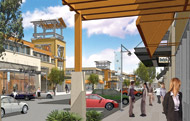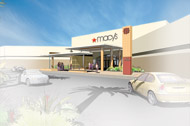| COVER STORY, MARCH 2007
DESIGN ON A TEXAS SCALE
Everything’s bigger in the state of Texas, even its idea of retail design.
Tipton Housewright
Cotton, cattle and oil have each ruled Texas at various times in the past and helped define the state’s identity. Today, however, retail has become king. Texans treat shopping as a sport, thus architects and developers are rising to the occasion and providing the latest innovations in shopping destinations.
So what is being offered to customers -— and tenants — to keep them coming back? The answer is in a number of trends, including mixed-use, density, community, convenience, luxury and sustainability.
The most exciting trend sweeping the retail industry today is mixed-use. Developers are increasingly bringing new projects on line that offer various combinations of retail, restaurant, hotel, office and residential. Some developers are even exploring partnerships with the community to provide parks, performance venues, libraries and city halls.
While retail often forms the backbone of a mixed-use project, the addition of other uses brings many benefits to not only the project, but the community as well. First, the owner can spread land costs over a wider variety of uses. Second, the additional uses provide captive customers for the retail shops and restaurants. Third, mixed-use projects provide convenience for the customer. And as automobile traffic increases throughout the region, mixed-use projects provide multiple offerings in one location, reducing time spent in the car.
 |
Designed by Omniplan, Rayzor Ranch will be a 412-acre mixed-use development in Denton, Texas.
|
|
One such example is the recently announced Rayzor Ranch mixed-use development in Denton. Designed by Omniplan, the 412-acre development will feature retail, residential, hotel, office and restaurant components as well as 15 acres of parks, walking trails and an outdoor amphitheater.
“There is a tremendous amount of synergy that exists in developing a project that includes a multitude of uses that all serve to benefit one another,” says Randy Holcombe, executive vice president of retail for Allegiance Development, developer of Rayzor Ranch. “Ultimately, everyone benefits — residents, tenants, office workers, shoppers and, most importantly, the community.”
Closely related to the mixed-use trend is the move toward greater density in retail development. Initially fueled by rising land prices, higher densities are beginning to make more sense. Since density can make a property more competitive by delivering more offerings to the customer, big box retailers are more comfortable with multi-story formats that incorporate structured parking. Density can also reach customers in urban areas and take advantage of locations on freeways or public transit lines. Adding density to an existing development is a great way to increase returns and bring new life to well-located properties.
Texans, and Americans in general, are living increasingly disconnected suburban lives. Today’s new town centers are bringing that missing sense of community to the suburbs and redeveloped urban areas. These projects often take the form of urban villages with plazas, fountains and amphitheaters, which contribute a civic feel to the development and provide residents and shoppers with a place to participate in community events, go for a walk or have a meal at a sidewalk café.
 |
Designed by Dallas-based Omniplan, Pearland Town Center will incorporate a park, which will be surrounded by restaurants. This space will see a wide variety of uses, including concerts, retail carts, games and art shows.
|
|
With Pearland Town Center in Pearland, Omniplan designed the center based on the concept that retail has become the driving force behind the urban village. Omniplan recognized the need for human interaction in our computer-centric society and incorporated a park, which is surrounded by restaurants, into the design. This space will see a wide variety of uses, including concerts, retail carts, games and art shows.
The desire for greater convenience is changing everything in our lives, from how we get our information to where we shop. Developers have responded to this movement with new shopping formats and new amenities that can give patrons a simpler, quicker shopping trip.
 |
Mall del Norte in Laredo, Texas, will offer outdoor areas.
|
|
While luxury can be related to convenience, it can also be defined as delivering an experience above and beyond the ordinary. Enclosed shopping mall formats are increasingly providing their customers with luxury merchandise and amenities. In contrast to the austere mall environments of previous decades, covered drop off entrances with valet parking, comfortable seating areas and lavish public restrooms are just some of the amenities customers can expect in today’s regional mall. For example, malls like Mall del Norte in Laredo are augmenting their existing offerings by adding outdoor areas, which can attract hip boutiques that wouldn’t normally be located in a traditional mall.
Cutting across all the market trends in retail and commercial development is the issue of sustainability. The concept of energy-efficient buildings designed in harmony with their climate and locale is a concept as old as architecture itself. During the 1970s’ oil crisis, energy-conscious architectural design was promoted as the way of the future. It was not until the late 1990s, however, that emphasis on sustainable design gained significant momentum, traveling beyond academia into mainstream design. Today, organizations such as the American Institute of Architects and the U.S. Green Building Council are leading proponents of sustainability, delivering training to industry professionals and providing means of measuring the environmental performance of buildings.
Sustainability is influencing everything about retail and commercial development. Site designers incorporate public transit, storm water detention and filtration and low-water landscapes; interior designers use recycled carpet and energy efficient lighting. Municipalities and other governing entities are beginning to require nominal levels of sustainable design in private projects, which is changing how projects are conceived and delivered.
The future of retail design in Texas is bright. Trends point to projects that will serve their communities and consumers better, create renewed urban life and take better care of the environment. The most successful developers, architects and contractors will be those that embrace these innovative trends and bring new and better projects to our cities.
Tipton Housewright, AIA, is principal of Omniplan, a Dallas-based architecture, interior architecture and planning firm specializing in the design of retail, commercial and higher education facilities.
©2007 France Publications, Inc. Duplication
or reproduction of this article not permitted without authorization
from France Publications, Inc. For information on reprints of
this article contact Barbara
Sherer at (630) 554-6054.
|
